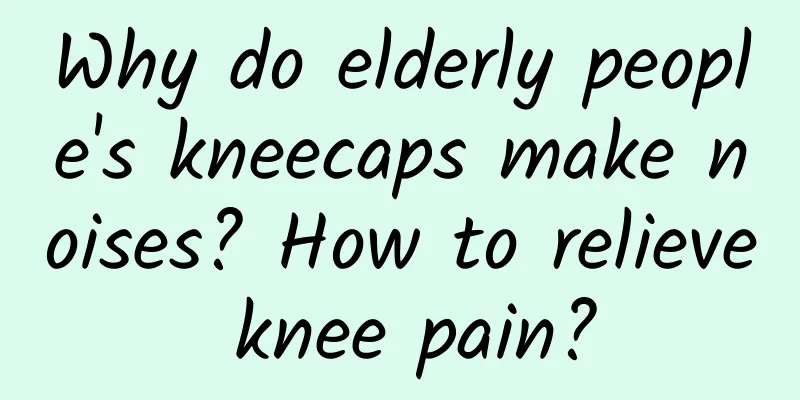Why do elderly people's kneecaps make noises? How to relieve knee pain?

|
The knee is our knee joint, which is a joint that we often move in our daily life, such as walking, running, climbing stairs, etc. Some people will have cold legs and knee pain when they get old, and some will have a clicking sound when they move their knees. Why do elderly people's kneecaps make noises?Knee cracking in the elderly is mainly related to cartilage wear. There is a layer of 2 to 4 mm thick transparent cartilage at the knee joint, which is composed of a small amount of cells, type II collagen fibers, proteoglycans and water, and has good elasticity and compression resistance. As people age, the cartilage in the joints of the human body degenerates. The cartilage becomes thinner and uneven due to wear and tear. Just like the gasket on a door hinge, it makes noise when it moves due to wear and tear. People whose joints occasionally crack should not overuse their joints. They should walk on flat ground as much as possible and rest every half an hour. They should avoid strenuous exercise, ride a bicycle less, go up and down stairs less, and do not climb mountains, so as not to aggravate joint wear and cause arthritis. Glucosamine and chondroitin sulfate have a certain effect on cartilage repair and can be supplemented appropriately. However, the number of cartilage cells is small and it is difficult to regenerate, especially for the elderly. The time for cartilage repair is very long, generally half a year or even longer. For people whose cartilage is almost worn out, the cartilage cannot regenerate and artificial joints must be replaced. How to relieve knee painFirst, keep your knees warm.Many elderly people suffer from knee pain caused by rheumatoid arthritis. If they do not keep warm enough in cold weather, the pain will often worsen. Therefore, the elderly must wear warm pants in the cold winter and prevent their knees from getting cold when sleeping at night to avoid cold air invading their knees. Second, strengthen exercise.Usually, you can relieve pain by strengthening the quadriceps, which are the muscles at the top of the knee. First, sit down and try to straighten your knees. Then, while keeping your knees straight, repeatedly contract the quadriceps, holding each contraction for 3 to 4 seconds, about 10 times a minute. Such long-term exercise can help promote blood circulation in the knees and relieve pain, but be careful to exercise in moderation each time. Third, massage the knee joint.Elderly people who experience knee pain can gently pat their knee joints for a few minutes each time. They can also massage the painful area. For areas with more severe pain, they can gently massage them more times. Why do knees hurt?Some people have knee pain, but no pain when walking on a flat surface. It is difficult for them to squat, stand up, and go up and down stairs. There is no impact on walking on a flat surface, and the joints are not red or swollen. The pain is in the front of the knee joint, which is most likely a popliteal muscle injury. The pain point of this problem is below the popliteal fossa behind the knee joint. This is a small muscle, but it is close to the tibial nerve. Once it is tense and painful, it will stimulate the nerve and cause pain in the front of the knee joint. This is also a knee flexor muscle. When the knee is flexed, the contraction further stimulates it, causing it to get worse! If the pain is on the inner side of the knee, consider pes anserine bursitis; if the pain is above the knee, consider quadriceps tendonitis; if the pain is on the outer side of the knee, consider biceps femoris injury, or iliotibial band tension and pain. People who like to run and have crooked legs have a high chance of getting this disease! In addition, patellar softening, synovitis with swelling and effusion of the knee joint, injuries to the medial and lateral collateral ligaments, meniscus injuries, and degeneration-induced pain are also not uncommon. Generally, an MRI is required to rule out intra-articular lesions before considering other causes! |
<<: Will agarwood rot if left for a long time? How to preserve agarwood for a long time?
>>: How to deal with the yellowing and falling leaves of gardenias?
Recommend
Classification of breast birads
The Breast Imaging Reporting and Information Syst...
Leucorrhea with blood after moxibustion
Many people often have bloody leucorrhea after mo...
Is it normal for a pregnant woman to have swollen legs at 5 months?
In today's society, people pay more attention...
What is the cause of intermittent stomach pain in pregnant women?
In the early stages of pregnancy, pregnant women ...
Will the baby stop breastfeeding if he doesn't drink milk at night?
If the baby does not drink milk at night, it will...
Will bacterial vaginosis heal on its own?
Bacterial vaginosis is bacterial vaginosis, which...
Normal menstruation, poor follicular development
Only when sperm and egg successfully combine can ...
What are the symptoms of menopausal women
In fact, the manifestations of menopause are very...
How to eliminate menstrual acne
We all know that during menstruation, various end...
What causes breast hyperplasia symptoms
Cystoma is neither a tumor nor an inflammation. F...
Attack of white lines - oral lichen planus
Zhang Ailing said: "Life is a gorgeous robe,...
Thirteen days after the abortion, there was a blood clot
Generally, after undergoing medical abortion, wom...
Why does it seem like practicing Tai Chi makes you taller? Can practicing Tai Chi help you grow taller?
Tai Chi, a world-class intangible cultural herita...
Is it painful to put on the Manlo Ring?
The Menlo Ring is a high-tech drug delivery ring ...
Is it pregnancy if the period is delayed for 2 days?
Generally, women find out they are pregnant by ca...









